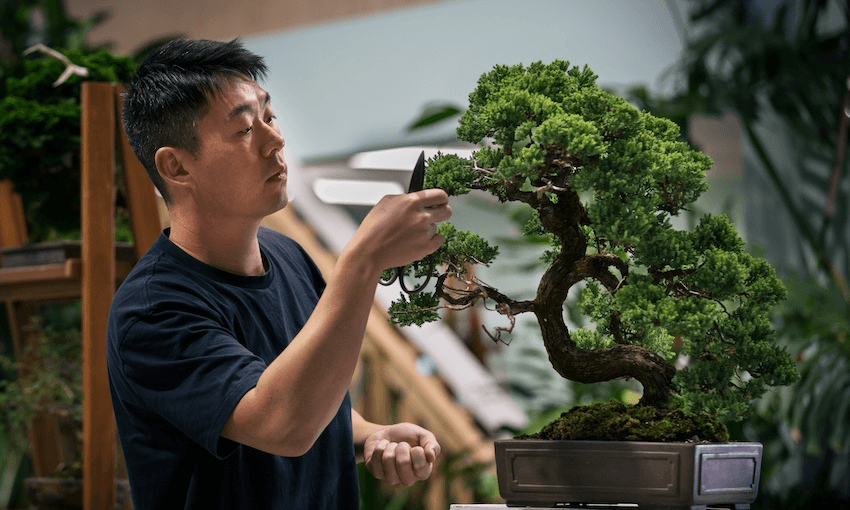The Generation Gardener is a short documentary about Steven Yin, owner of Wellington’s MiniGardens Bonsai, the largest bonsai nursery in New Zealand. Here, Steven offers some tips on looking after ‘the pet tree’.
Bonsai is more than just a horticultural practice; it is a philosophy that invites us to slow down, appreciate the beauty of nature in miniature, and reflect on the interconnectedness of all living things. Through the careful cultivation of these tiny trees, we learn profound lessons about patience, mindfulness, and the transient nature of life. Caring for a bonsai is not just a hobby; it is a journey that fosters a deep connection to the natural world and provides a source of tranquillity in our busy lives.
At MiniGardens Bonsai NZ, we call bonsai “the pet tree”. Like raising a dog or a cat, your tree also requires your daily attention – it needs water, food, sunlight and most of all, your love and care!
Display
Your bonsai tree should be placed outdoors at all times. Ideally on a deck or an outdoor table, it can be displayed inside for a special occasion but for no more than 3 days at a time. Don’t move your tree too often, frequently changing its environment will cause it to deteriorate.
Watering
Check your tree for watering daily. Humans need water daily, and so does your tree. Water thoroughly each time you water – keep the soil moist at all times. The best watering time is morning or evening. Reduce watering in winter, and increase the amount of water in spring and summer.
Feeding
Fertilise your tree during the growing seasons (September-April). Use slow-release fertiliser pellets or liquid fertilisers if you wish to. We like New Zealand products so our choice is the Tui brand.
Beyond being a horticultural practice, bonsai carries profound meanings in our lives, teaching us meaning in patience, mindfulness, and the interconnectedness of all living things.
Patience and contemplation
Bonsai is a living art that demands patience and mindfulness. The process of shaping a bonsai tree involves careful pruning, wiring, and training over many years. This slow and deliberate approach teaches practitioners the value of patience and the rewards of sustained effort. Bonsai enthusiasts often find solace in the meditative process of caring for their miniature trees, fostering a sense of calm and contemplation in the midst of our fast-paced lives.
Reflection of nature
Bonsai serves as a tangible representation of nature in a confined space. The meticulous design and shaping of a bonsai tree aim to capture the essence of a full-sized tree, including its natural beauty and harmony. The miniature landscapes created by bonsai artists reflect the cycles of life, the changing seasons, and the resilience of nature. Observing a well-crafted bonsai can evoke a sense of connection to the broader natural world, fostering an appreciation for the beauty of simplicity and the cyclical nature of life.
Symbolism and culture
Bonsai carries deep cultural and symbolic significance, particularly in Japanese culture. It is associated with principles of balance, harmony, and respect for the passage of time. In Japanese philosophy, bonsai represents the transient nature of life and the beauty found in impermanence. The art encourages a profound understanding of the interconnectedness between the artist, the tree, and the viewer – a reminder of the interdependence that characterises our relationships with the environment and each other.
The Generation Gardener is part of Someday Stories, a six episode series made by emerging young New Zealand filmmakers. Directed by Luke Ross and produced by Alice Youngquest.


